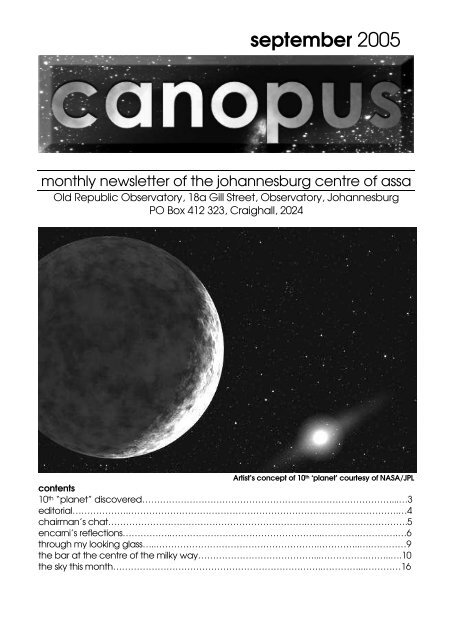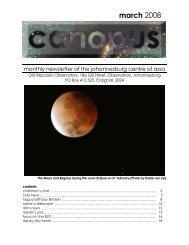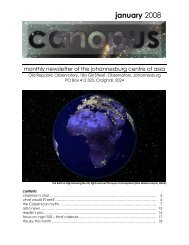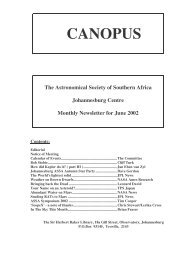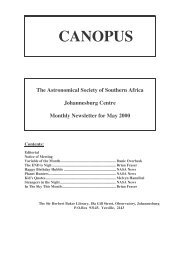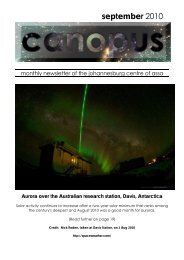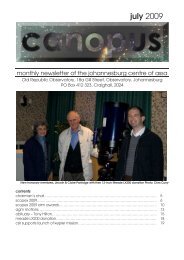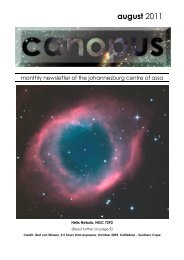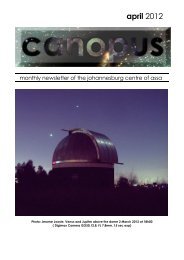Canopus September 2005 - Astronomical Society of Southern Africa
Canopus September 2005 - Astronomical Society of Southern Africa
Canopus September 2005 - Astronomical Society of Southern Africa
Create successful ePaper yourself
Turn your PDF publications into a flip-book with our unique Google optimized e-Paper software.
september <strong>2005</strong><br />
monthly newsletter <strong>of</strong> the johannesburg centre <strong>of</strong> assa<br />
Old Republic Observatory, 18a Gill Street, Observatory, Johannesburg<br />
PO Box 412 323, Craighall, 2024<br />
Artist’s concept <strong>of</strong> 10 th ‘planet’ courtesy <strong>of</strong> NASA/JPL<br />
contents<br />
10 th “planet” discovered…………………………………………………………………………...…3<br />
editorial……………….……………………………………………………………………………….…4<br />
chairman’s chat………………………………………………………….…………………………….5<br />
encarni’s reflections……………..…………………………………………...………….………….…6<br />
through my looking glass…..……………………………………………….…………..….…………9<br />
the bar at the centre <strong>of</strong> the milky way…………………………………...…………….……..….10<br />
the sky this month……………………………………………………………..…………...…………16
canopus september <strong>2005</strong><br />
notice <strong>of</strong> next meeting – assa johannesburg<br />
The next monthly meeting <strong>of</strong> the Johannesburg Centre <strong>of</strong> the <strong>Astronomical</strong> <strong>Society</strong> <strong>of</strong> <strong>Southern</strong> <strong>Africa</strong> will be held at<br />
the old Republic Observatory, 18a Gill Street, Observatory, Johannesburg on Wednesday 14 <strong>September</strong> <strong>2005</strong> at<br />
20h00. Guest speaker:<br />
Robert Groess<br />
“Amongst the Vagabonds: Pluto and its icy siblings”<br />
“The Planets” series, hosted by Dave Gordon, will feature Pluto in conjunction with the guest<br />
speaker to make this evening a PLUTO SPECIAL<br />
upcoming meetings calendar<br />
12 October meeting: Dries van Zyl – ‘Weather and atmospheric phenomena’<br />
9 November meeting: Okkie de Jager – ‘HESS’<br />
assa johannesburg committee members &<br />
volunteers for <strong>2005</strong>/2006<br />
Portfolio/Interest Name E-mail Contact details<br />
Chairman Brian Fraser (016) 366 0955 after hours<br />
<br />
Vice-chairman Chris Curry <br />
Hon. Secretary Lerika Cross 082 650 8002<br />
Hon. Treasurer Dave Gordon (011) 702 1219<br />
Curator <strong>of</strong> instruments Dave Hughes 082 412 6665<br />
ATM Keith Lou 083 756 7206<br />
ATM Chris Stewart (011) 763 3301 after hours<br />
PR & Media Liason Sharon Tait (011) 477 7512<br />
PR & Media Liason Karen Breytenbach 083 302 9494<br />
Librarian Alec Jamieson (011) 886 7288<br />
Webmaster Nils Schwarz <br />
<strong>Canopus</strong> Editor Robert Groess 083 365 8092<br />
<br />
Volunteers: <br />
Beginners’ class Ed Finlay <br />
Library Ilse von Willich <br />
Library Atze Herder (011) 648 3729 or 083 456 4159<br />
HobbyX, Viewing,<br />
Beginners Class<br />
Jerome Jooste (011) 312 0111 or 072 985 8764<br />
(wife Jana) 072 477 2588<br />
Viewing, ATM Bruce Dickson <br />
Evan Dembskey <br />
ATM: Amateur Telescope Making classes held on the premises <strong>of</strong> Parktown Boys High School on most<br />
Saturday afternoons.<br />
ASSA Johannesburg Centre’s mailing-list subscriptions:<br />
Announcements and discussion, send a blank email to: !<br />
ATM class'mailing list, send a blank email to: !<br />
page 2
canopus september <strong>2005</strong><br />
10 th “planet” discovered<br />
edited version <strong>of</strong> NASA/JPL article<br />
A planet larger than Pluto has been discovered in the outlying regions <strong>of</strong> the solar system.<br />
The planet was discovered using the 48-inch Samuel Oschin Telescope at Palomar<br />
Observatory near San Diego, California, and was announced by planetary scientist Dr.<br />
Michael Brown <strong>of</strong> the California Institute <strong>of</strong> Technology on Friday 29 July <strong>2005</strong>.<br />
The planet is a typical member <strong>of</strong> the Kuiper belt, but its sheer size in relation to the nine<br />
known planets means that it can only be classified as a planet. Currently about 97 times<br />
further from the Sun than the Earth, the planet is the furthest known object in the solar<br />
system, being the third brightest <strong>of</strong> the Kuiper belt objects, and lies 45 degrees outside the<br />
plane <strong>of</strong> the ecliptic.<br />
“It will be visible with a telescope over the next six months and is currently almost directly<br />
overhead in the early-morning eastern sky, in the constellation Cetus,” said Brown, who<br />
made the discovery with colleagues Chad Trujillo, <strong>of</strong> the Gemini Observatory in Mauna<br />
Kea, Hawaii, and David Rabinowitz, <strong>of</strong> Yale University, New Haven, on January 8, <strong>2005</strong>.<br />
Brown, Trujillo and Rabinowitz first photographed the new planet on October 31, 2003.<br />
However, the object was so far away that its motion was not detected until they reanalyzed<br />
the data in January <strong>of</strong> this year. In the last seven months, the planet has been studied to<br />
better estimate its size and its motions.<br />
The size <strong>of</strong> a solar system object can be inferred by its reflectivity. And while the<br />
reflectance <strong>of</strong> the planet is not yet accurately known, the amount <strong>of</strong> light it does reflect puts<br />
a lower limit on its size. “Even if it reflected 100 percent <strong>of</strong> the light reaching it, it would<br />
still be as big as Pluto,” says Brown. “I'd say it's probably one and a half times the size <strong>of</strong><br />
Pluto, but we're not sure yet <strong>of</strong> the final size.” Observations using NASA's Spitzer Space<br />
Telescope put an upper limit on its size since Spitzer is unable to detect the new planet.<br />
Therefore the overall diameter must be less than 2,000 miles (3,200 km), according to<br />
Brown.<br />
Brown's team has submitted a name for its proposed planet to the IAU, but until an <strong>of</strong>ficial<br />
statement is given, its designation will remain 2003UB313. The media have popularised<br />
rumours that the planet has been called Xena, named after the lead actress in the TV series<br />
“Xena, Warrior Princess”.<br />
For more information and images see:<br />
! "#$%"& <br />
! <br />
page 3
canopus september <strong>2005</strong><br />
editorial<br />
Robert Groess<br />
Firstly, a very big thank you to the overwhelmingly positive response I’ve received with<br />
regard to the August edition. I would also like to thank those who have sent in countless<br />
articles for <strong>Canopus</strong>, and while not every article may see the light <strong>of</strong> day, I do appreciate<br />
your submissions very much.<br />
And now, it gives me great pleasure in introducing you to SALT Astronomer, Dr. Encarni<br />
Romero Colmenero, who will feature regularly in <strong>Canopus</strong> with her own column. There are<br />
six permanent SALT Astronomers who take turns in commanding the giant reflector in the<br />
heart <strong>of</strong> the Klein Karoo, and Encarni was the first to be appointed as such in November<br />
2004. She is no stranger to South <strong>Africa</strong>, having worked at SAAO in Cape Town for the<br />
past six years, and as such has seen SALT being born and grow up in front <strong>of</strong> her eyes. We<br />
look forward to Encarni’s reflections (11m and others) on her astronomical world in months<br />
to come.<br />
You would no doubt have seen the list <strong>of</strong> committee members which will serve for the<br />
current year – some portfolios retaining the status quo even though there was significant<br />
emphasis on trying to breathe great change into the committee. Truth be told, there are<br />
particular committee members who are very well suited to their portfolios and decisions<br />
were essentially unanimous in (re)electing them to their positions. There are also numerous<br />
new committee members who have been welcomed onboard and we look forward to an<br />
exciting and entertaining <strong>2005</strong>/2006.<br />
This issue <strong>of</strong> <strong>Canopus</strong> promotes the hype about one “planet”, provisionally named “Xena”,<br />
while downplays the hype about another, Mars. At first I wasn’t going to consider putting in<br />
anything about the Mars hoax, but since it has acquired such momentum <strong>of</strong> it own, I have<br />
decided to put in a little piece Karen Breytenbach wrote to expose the hoax as a matter <strong>of</strong><br />
clarification.<br />
One thing I would like to encourage is the use <strong>of</strong> some pictures and diagrams in <strong>Canopus</strong>.<br />
There have been reasons why images have not been reproduced with satisfactory quality in<br />
times gone by, but with the experience passed on to me from those editors and some tricks<br />
I’ve adopted, together with our printers who do a great job in terms <strong>of</strong> quality, I think it is<br />
indeed feasible to enhance the graphic content <strong>of</strong> <strong>Canopus</strong> which would make it even more<br />
pleasing to the eye.<br />
Thank you once again for your interest in reading <strong>Canopus</strong> and as always, I welcome any<br />
feedback you may have.<br />
The Editor.<br />
page 4
canopus september <strong>2005</strong><br />
chairman’s chat<br />
Brian Fraser<br />
We are now into the new year, have a fresh committee with many new faces and look ahead<br />
to an interesting year <strong>of</strong> astronomy. Already your committee have lined up an interesting<br />
list <strong>of</strong> speakers that will take us through to about the year end.<br />
Our year started <strong>of</strong>f on a sour note with yet another burglary at the Sir Herbert Baker<br />
building, which houses our meagre possessions, which are now even more meagre with the<br />
loss <strong>of</strong> more than half the chairs from the hall. So now we could not hold meetings there,<br />
even if we wanted to. We are having discussions with our landlords, SAASTA, to use a<br />
storage room at the bottom <strong>of</strong> the hill which we hope will be more secure.<br />
I am writing this the day after our Jupiter viewing evening and can report that it was a huge<br />
success with over 100 visitors. Huge thanks to the handful <strong>of</strong> members who helped out,<br />
especially with the bringing <strong>of</strong> telescopes and the providing <strong>of</strong> catering.<br />
The keenest aspect <strong>of</strong> amateur astronomy for me is taking part in observational astronomy.<br />
By that I include the observing <strong>of</strong> variable stars, occultations, minor planet occultations,<br />
lunar occultations and observing the occasional meteor showers. There are other amateurs<br />
who also observe sun spot activity and monitor comets. All <strong>of</strong> which can be done in the<br />
backyard with a small telescope.<br />
Our group <strong>of</strong> active minor planet<br />
observers is very small. Nevertheless, we<br />
have managed to observe 5 events in the<br />
past few months. However our results<br />
would be a lot more valuable if we had<br />
positive results from more observers, for<br />
in each case we had only one positive<br />
“hit”. If any <strong>of</strong> our members would like to<br />
do some real valuable worthwhile<br />
astronomy, at your leisure, in your own<br />
backyard, then please let me know. We<br />
would love to have your observations.<br />
Clear skies,<br />
Brian Fraser<br />
page 5
canopus september <strong>2005</strong><br />
encarni’s reflections<br />
Encarni Romero Colmenero – erc@saao.ac.za<br />
Hi there,<br />
First <strong>of</strong> all, let me introduce myself. As you may have read above, my name is Encarni<br />
(pronounced 'N'-'car'-'knee') and I am one <strong>of</strong> the <strong>Southern</strong> <strong>Africa</strong>n Large Telescope (SALT)<br />
astronomers. In fact, I have the honour <strong>of</strong> being the first ever SALT astronomer, which<br />
caused me no end <strong>of</strong> troubles (and interviews) when my over-proud father mentioned it to a<br />
local journalist friend <strong>of</strong> his, who misunderstood 'first' as being 'lead', and promptly printed<br />
an article in the local paper announcing my being the director <strong>of</strong> the largest telescope in the<br />
southern hemisphere! Luckily for me, my father lives in Spain, so nobody at the SAAO or<br />
at SALT found out about it. Shhh!<br />
Over the next few months, I will<br />
be sharing what I consider to be<br />
interesting titbits <strong>of</strong> my<br />
astronomical world with all <strong>of</strong> you,<br />
and I do sincerely hope you also<br />
find them at least a little bit<br />
entertaining. Let me know what<br />
you think anyway - feedback (even<br />
negative feedback) is always good.<br />
Anyway, I was not going to talk<br />
about SALT at all in my first ever<br />
appearance in <strong>Canopus</strong>, but the<br />
latest SALT news are so exciting<br />
that I'm afraid I can't help myself.<br />
In early August, Dr. Darragh O'Donoghue, whose team have developed the imaging camera<br />
on SALT (called SALTICAM) and Dr. David Buckley, project scientist for SALT, were at<br />
the telescope for the commissioning <strong>of</strong> SALTICAM. They took some stunning UBVRI<br />
images <strong>of</strong> some famous night sky objects, and the most amazing lightcurves <strong>of</strong> an eclipsing<br />
binary system I have seen… at 200 milliseconds time resolution! Unfortunately I can't give<br />
you a sneak preview <strong>of</strong> these until they have been <strong>of</strong>ficially released, but I promise to post<br />
them then. So it looks like we are pretty much ready for the beginning <strong>of</strong> the SALTICAM<br />
Performance Verification phase on the 23rd <strong>of</strong> August, when we will finally start taking<br />
scientific data for all <strong>of</strong> the international SALT partners. Hurrah!<br />
And on that happy note, I sign <strong>of</strong>f. Until next month!<br />
Encarni.<br />
page 6
canopus september <strong>2005</strong><br />
discovery lands safely<br />
by Thom Patterson (CNN)<br />
The space shuttle Discovery touched down Tuesday morning, August 9, <strong>2005</strong>, completing<br />
NASA's first shuttle mission since Columbia broke apart during re-entry in February 2003.<br />
The shuttle landed at 5:11 a.m. (14:11 SAST) at NASA's<br />
secondary landing site at Edwards Air Force Base in<br />
California, the 50 th landing at Edwards. With Discovery<br />
safely back on Earth, NASA <strong>of</strong>ficials breathed a huge sigh<br />
<strong>of</strong> relief.<br />
The landing capped a 14-day mission largely designed to<br />
improve safety on future shuttle journeys, although the<br />
program has been suspended while NASA investigates its<br />
failure to solve the problem <strong>of</strong> foam falling from the shuttle's external liquid fuel tank<br />
during launch. The shuttle spent most <strong>of</strong> the mission docked to the space station, delivering<br />
much-needed supplies and performing maintenance on the outpost.<br />
Discovery's path to Edwards began with the spacecraft firing its engines over the Indian<br />
Ocean to slow it enough to re-enter Earth's atmosphere over the Pacific.<br />
Shuttle pilot James Kelly steered Discovery on a trajectory leading it near Los Angeles and<br />
Oxnard, California, before touch down.<br />
NASA <strong>of</strong>ficials vowed to land the orbiter on that Tuesday at one <strong>of</strong> three locations after<br />
weather conditions forced them to scrub the shuttle's scheduled return a day earlier. The<br />
Kennedy Space Center in Florida was NASA's first choice. Edwards their second and<br />
White Sands Missile Range in New Mexico their third. Weather conditions at Edwards<br />
included clear skies and light winds, "excellent conditions for a space shuttle landing,"<br />
NASA said.<br />
Officials would have preferred to land at Kennedy Space Center to avoid the cost and<br />
inconvenience <strong>of</strong> flying the shuttle back to its launch site from the alternative landing strips.<br />
Discovery will stay in California for nine or 10 days before being ferried back to Florida on<br />
the back <strong>of</strong> a specially designed aircraft.<br />
NASA administrator Michael Griffin said he didn't want to guess on when the next shuttle,<br />
Atlantis, would launch but said the agency would try hard to get back into space by the end<br />
<strong>of</strong> the year.<br />
page 7
canopus september <strong>2005</strong><br />
mars hoax<br />
by Karen Breytenbach – excerpt <strong>of</strong> a press release sent to news24.com, amongst others<br />
Reports are circulating via e-mail, suggesting that on 27 August <strong>2005</strong> Mars will appear as<br />
large to terrestrial observers as the Moon. These statements are bogus and misleading.<br />
“We've been inundated with enquiries regarding this e-mail, which has been circulating for<br />
some time,” says [Brian] Fraser. “This e-mail, with the subject line ‘Mars is going to be a<br />
second moon <strong>of</strong> earth for a day’, started <strong>of</strong>f as a confusing note in 2003, about the Earth-<br />
Mars proximity <strong>of</strong> that year. It has been re-circulated this year, and mistakes are being<br />
added to it as it passes around, which is pretty typical for bogus e-mails. But you can ignore<br />
it. Under no circumstances will Mars appear as large as the moon.”<br />
Roughly once every 26 months the orbits <strong>of</strong> Earth and Mars bring the two planets into<br />
relatively “close” proximity, this being a bit over 56 million km. Nevertheless Mars is quite<br />
small, only about 6,700km in diameter, i.e. about half the size <strong>of</strong> Earth. Therefore even at a<br />
“close” approach, the planet appears to the naked eye as no more than a bright point <strong>of</strong><br />
light. The Johannesburg Planetarium has set up a Web page at ! <br />
explaining how the <strong>2005</strong> encounter compares with that <strong>of</strong> 2003. NASA provides further<br />
details on their site, $""&"#'(<br />
The <strong>2005</strong> closest approach to Mars will be on 30 October (not 27 August), Fraser advises.<br />
“Mars is already very attractive: it's right overhead just before sunrise. As the year<br />
progresses, so it will move over to the western morning sky, and by October it will appear<br />
in the evening sky. This has been a spectacular year for astronomical phenomena, and Mars<br />
is no exception: but it will not appear as large as this e-mail suggests. We urge anyone<br />
receiving the mail not to forward it, but to simply delete it.”<br />
page 8
canopus september <strong>2005</strong><br />
through my looking glass<br />
Ed Finlay<br />
The winter triangle <strong>of</strong> stars is still prominent in the north at this time <strong>of</strong> the year. About 20<br />
degrees above the horizon west <strong>of</strong> north you can see Vega, the fifth brightest star in the<br />
heavens. At about 18 degrees above the horizon to the north east is Deneb, the nineteenth<br />
brightest star and almost on the meridian at 58 degrees altitude is Altair, the twelfth<br />
brightest star. They stand out above all other stars so they are easy to find.<br />
Vega, the first star <strong>of</strong> the constellation Lyra, is a dazzling white star <strong>of</strong> magnitude 0.04; it<br />
was the first star to be photographed by the daguerreotype process at the Harvard<br />
Observatory (July 17, 1850). Because <strong>of</strong> the precession <strong>of</strong> the Earth’s polar axis, this was<br />
the pole star 14,000 years ago.<br />
Deneb marks the tail <strong>of</strong> Cygnus the Swan and has a magnitude <strong>of</strong> 1.26. Lying at the head <strong>of</strong><br />
Cygnus, is the famous wide double star, Albireo. The orange component is magnitude 3.9<br />
and the blue 5.11. Agnes Clerk wrote at the end <strong>of</strong> the 19th century, “perhaps the most<br />
lovely effect <strong>of</strong> colour in the heavens”. We have a copy <strong>of</strong> one <strong>of</strong> her books, “The System<br />
<strong>of</strong> the Stars” in our library. Look it up sometime!<br />
Altair, magnitude 0.8 is the first star <strong>of</strong> the constellation Aquilla, the Eagle. It was the<br />
standard first magnitude star in Pogson’s photometric scale. Historically, it was used to<br />
determine lunar distances at sea, and it was a fundamental for Flamsteed in his solar<br />
observations. Spectroscopic studies show that Altair is rotating at 258 km/s, a truly<br />
remarkable speed. One Altair day is completed in 61½ hrs. By comparison, the Sun takes<br />
more than 25 Earth days to complete one revolution.<br />
Look for M57, the famous Ring Nebula between the stars Beta and Gamma Lyrae. This<br />
was the first planetary nebula to be discovered. Antoine Darquier, <strong>of</strong> Toulouse noted it in<br />
1722. It was Sir William Herschel who first called this type <strong>of</strong> object a ‘planetary’, not<br />
because he imagined them to be planets but because they reminded him <strong>of</strong> the discs or<br />
globes <strong>of</strong> planets; and their predominantly green colour was similar to the greenish tint <strong>of</strong><br />
the planet Uranus which he discovered in 1781.<br />
A planetary nebula is the ejected product <strong>of</strong> an old star with a mass no greater than 1.4 solar<br />
masses, in the first stages <strong>of</strong> its final evolution to a white dwarf. Material thrown <strong>of</strong>f from<br />
its outer layers expands to form a gaseous “bubble” or shell. The ring-like appearance is<br />
actually an optical illusion owing to reflection, scattering and ionization <strong>of</strong> the central stars’<br />
light at the outer boundaries <strong>of</strong> the nebula with relation to our line <strong>of</strong> sight. Using an 8inch<br />
telescope my logbook records a small, faint blue-green luminous ring, like a smoke ring.<br />
More next month,<br />
Ed.<br />
page 9
canopus september <strong>2005</strong><br />
the bar at the centre <strong>of</strong> the milky way<br />
edited excerpt from a University <strong>of</strong> Wisconsin, Madison News Release<br />
Using NASA's Spitzer Space Telescope, astronomers have created a detailed survey <strong>of</strong> the<br />
structure <strong>of</strong> the Milky Way. Based on this evidence, they think the shape <strong>of</strong> the Milky Way<br />
is more complex than a plain old spiral. Our galaxy seems to have a long central bar,<br />
approximately 27,000 light-years in length. From our vantage point going around the Sun,<br />
we see this bar at a 45-degree angle.<br />
The survey using the Earth-trailing infrared telescope in orbit about the Sun, provides the<br />
fine details <strong>of</strong> a long central bar feature that distinguishes the Milky Way from more<br />
pedestrian spiral galaxies.<br />
“This is the best evidence ever for<br />
this long central bar in our<br />
galaxy,” says Ed Churchwell, a<br />
UW-Madison pr<strong>of</strong>essor <strong>of</strong><br />
astronomy and a senior author <strong>of</strong><br />
a paper describing the new work<br />
in an upcoming edition <strong>of</strong><br />
Astrophysical Journal Letters.<br />
Above: Simulation <strong>of</strong> our Milky Way Galaxy (UW-Madison)<br />
The group <strong>of</strong> astronomers<br />
surveyed some 30 million stars in<br />
the plane <strong>of</strong> the galaxy in an effort<br />
to build a detailed portrait <strong>of</strong> the<br />
inner regions <strong>of</strong> the Milky Way.<br />
The task, according to<br />
Churchwell, is like trying to<br />
describe the boundaries <strong>of</strong> a forest<br />
from a vantage point deep within<br />
the woods: “This is hard to do<br />
from within the galaxy.”<br />
Spitzer's capabilities, however, helped the astronomers cut through obscuring clouds <strong>of</strong><br />
interstellar dust to gather infrared starlight from tens <strong>of</strong> millions <strong>of</strong> stars at the centre <strong>of</strong> the<br />
galaxy. The new survey gives the most detailed picture to date <strong>of</strong> the inner regions <strong>of</strong> the<br />
Milky Way.<br />
Galactic bars are far more prevalent than previously anticipated. Approximately 70% <strong>of</strong> all<br />
spiral galaxies have a central bar when imaged in the near infrared. This contrasts strongly<br />
with the previous assumption that bars are few and far between!<br />
page 10
canopus september <strong>2005</strong><br />
amateur telescope makers’ dialog<br />
compiled by Chris Stewart<br />
Actual e-mail exchange between two ATM exponents:<br />
ATME1:<br />
I'll happily bring my two telescopes (6" and 7") and assist wherever else I can.<br />
ATME2:<br />
Would have thought the 10-inch would be finished by then.<br />
ATME1:<br />
Another coat <strong>of</strong> paint to go.<br />
ATME2:<br />
On the mirror!?! <br />
ATME1:<br />
Well, I couldn't afford the SiO 2 coating but found some really reasonably priced marine<br />
varnish and, seing [sic] I do go to the coast from time to time, thought that this would be<br />
quite appropriate. Only thing is, it takes forever to dry…<br />
ATME2:<br />
I'm relieved to hear that, 'cause paint is a<br />
whole different matter from varnish.<br />
(Paint doesn't show <strong>of</strong>f the grain nearly<br />
as nicely.) I painted all my old eyepieces<br />
matte-black, because they didn't come<br />
with anti-reflection coatings and I heard<br />
they perform better if they are antireflection<br />
coated. They looked nice. But<br />
now I have new eyepieces.<br />
Seriously though, in the days <strong>of</strong><br />
chemically-deposited silver coatings,<br />
some people did put a thin layer <strong>of</strong><br />
lacquer varnish on the mirrors. True, the<br />
varnish degraded the image, but not<br />
nearly as badly as the tarnishing did,<br />
and then the coating lasted much<br />
longer.<br />
page 11
canopus september <strong>2005</strong><br />
assa events<br />
<strong>Africa</strong>n <strong>Astronomical</strong> History Symposium<br />
Second Announcement<br />
Timetable<br />
Dates: <strong>2005</strong> November 8 & 9<br />
Venue:<br />
Website:<br />
Email:<br />
New lecture room facility at SAAO, Cape Town.<br />
(Map: !)<br />
<br />
<br />
Contact: Dr I.S. Glass, SAAO, P.O. Box 9, Observatory, 7935<br />
Tel: (021) 447 0025 Fax: (021) 447 3639<br />
1 August <strong>2005</strong> Registration / Proposals for talks opens. (Please do not leave until<br />
the last minute. Uncertainty is our greatest enemy and can lead to<br />
costly problems!). Please note that the venue can accommodate<br />
about 80 participants.<br />
15 October Last day to notify us <strong>of</strong> proposed talks.<br />
7 November Pre-conference wine and cheese, McClean telescope, SAAO.<br />
8 November AAHS, Ethno-astronomy sessions.<br />
Conference dinner, Wild Fig, Courtyard Hotel.<br />
9 November AAHS, Classical astronomy sessions.<br />
10 November Opening <strong>of</strong> SALT<br />
Costs<br />
The registration charge <strong>of</strong> R100 will cover tea, c<strong>of</strong>fee, biscuits, the pre-conference reception and a copy <strong>of</strong><br />
the proceedings.<br />
Conference Dinner<br />
We envisage having a dinner at the Wild Fig restaurant on 8 November, at a cost <strong>of</strong> R115 per person. This is a<br />
part <strong>of</strong> the Courtyard Hotel close to SAAO, Cape Town.<br />
Opening <strong>of</strong> SALT<br />
Many participants, especially those from up-country, may wish to visit Sutherland for the opening <strong>of</strong> the <strong>Southern</strong><br />
<strong>Africa</strong>n Large Telescope, which is now scheduled for 10 November. It is evident that the <strong>of</strong>ficial guests <strong>of</strong> the<br />
Department <strong>of</strong> Science and Technology, the National Research Foundation and the SALT partner institutions will<br />
fill up all the space available within the dome for the event. It therefore appears that conference participants, if<br />
they want to be there, will have to be content with watching events on a large-screen TV in the Visitor Centre.<br />
There will be an opportunity to visit the telescope dome after the opening.<br />
page 12
canopus september <strong>2005</strong><br />
obituary<br />
It is with sadness that I must report the passing <strong>of</strong> Pam Cook on 16 July. Pam was one <strong>of</strong><br />
the more prolific Solar observers in this country, whose regular flow <strong>of</strong> observing reports to<br />
the Section was only curtailed by circumstances. Her rare intellect and a warm personality<br />
will be missed by all who knew her; it was my privilege to have done so for almost two<br />
decades. Her husband Jack (also a long-term amateur astronomer and ATM exponent)<br />
provides the following commentary. Our thoughts are with Jack and his family in this time<br />
<strong>of</strong> sorrow.<br />
Regards,<br />
Chris Stewart<br />
Astronomy and Pam Cook<br />
Pam's lifelong interest, and forte, was mathematics. When there were no "serious" things for<br />
her to apply her mind to, she loved to sit with pencil and paper, working through some or<br />
other self-set problem for her own satisfaction and amusement. If she was not happy with<br />
the conclusions she reached then... she would return to the start and worry the problem until<br />
she arrived at the result that she sought and believed was correct.<br />
It seemed natural that Astronomy <strong>of</strong>fered a perfect outlet for Pam's talents. Pam found<br />
many astronomical views and conclusions controversial to her thinking. When this was so,<br />
she would delve deeper and deeper into the matter, quite regardless <strong>of</strong> time and effort, until<br />
she was satisfied with the outcome, whether or not she could disprove the “book”.<br />
Pam was delighted to view sky objects, either unassisted or using a telescope. However, she<br />
was never at a loss because <strong>of</strong> viewing conditions, she would simply use her desk and<br />
writing materials to immerse herself far into her current interest; a happy way to have the<br />
best <strong>of</strong> things, come rain, cloud or any other obstacle to good viewing.<br />
Pam became very interested in Solar activity, and recording and pondering events that she<br />
observed. She liked to discuss matters with Jim Knight, the Director <strong>of</strong> that Section <strong>of</strong><br />
ASSA. Intelligent conversation was one <strong>of</strong> her basic needs.<br />
Pam passed away on 16th July <strong>2005</strong> after a long fight with illness. She is very much missed<br />
by her friends and family.<br />
Jack Cook<br />
page 13
canopus september <strong>2005</strong><br />
books & media<br />
Available to buy at 20% discount:<br />
Meteorite Impact!: the danger from Space<br />
and South <strong>Africa</strong>'s mega-impact<br />
The Vredefort Structure<br />
by WU Reimold and RL Gibson<br />
ISBN 1-919908-62-5<br />
R180.00<br />
Order and Collect books from Lerika Cross<br />
email: lerika@icon.co.za<br />
tel: 082 650 8002<br />
Payments must be made out to:<br />
ASSA Johannesburg Centre<br />
(Details next page under subscription info.)<br />
This workbook (25 star charts) is available as a free<br />
download on the internet at:<br />
<br />
by Auke Slotegraaf<br />
In line with ASSA Council's recent emphasis on practical<br />
observing, I've developed the "Discover!" project, a 32-page<br />
workbook aimed at teaching the rank beginner all the<br />
constellations visible from the southern hemisphere. For those<br />
familiar with the brighter constellations, it serves as an<br />
introduction to the deep sky by encouraging them to search for<br />
deepsky objects (star clusters, galaxies, etc.) hidden amongst<br />
the stars. Unlike other star charts, no deepsky objects are plotted<br />
on these maps - you have to discover them for yourself!<br />
Once a map has been thoroughly examined, send your<br />
annotated star chart and observing notes to:<br />
The ASSA Deepsky Section<br />
Director: Auke Slotegraaf,<br />
Forelle Crescent 8, Die Boord<br />
Stellenbosch<br />
7600<br />
email: <br />
Your observations will be returned along with detailed feedback!<br />
page 14
canopus september <strong>2005</strong><br />
*urgent* – subscription renewals for <strong>2005</strong>/2006<br />
REMINDER:<br />
Thank you to all members who have paid their subscription fees for <strong>2005</strong>/2006. For those<br />
<strong>of</strong> you that still need to renew your subscriptions, please note that the new (reduced)<br />
subscription rates for <strong>2005</strong>/2006 have been set as follows:<br />
Ordinary: R 120.00<br />
Pensioners/Students: R 60.00<br />
New Member Joining Fee R 50.00<br />
The family category has been done away with. Families pay the ordinary fee (i.e.: R 120 per family) as they<br />
are issued with one copy <strong>of</strong> <strong>Canopus</strong> per family. The subscription period corresponds to the Centre’s<br />
administrative year, 1 July <strong>2005</strong> to 30 June 2006.<br />
Details to pay directly into the Centre’s bank account:<br />
Please contact the Treasurer, Dave Gordon, (011) 702 1219, and notify him <strong>of</strong> your deposit/transfer.<br />
Bank: Nedbank<br />
Acc. No.: 1921 013761<br />
Acc. Name: ASSA Johannesburg Centre<br />
Acc. Type: Current Account<br />
Branch: Park Plaza<br />
Branch No.: 19 21 42 44<br />
Alternatively please mail cheques marked “Not Transferable” made out to<br />
“ASSA Johannesburg Centre”, to PO Box 412 323, Craighall, 2024<br />
IMPORTANT:<br />
Please note that if you do not renew your subscriptions, you will be removed from the<br />
<strong>Canopus</strong> mailing list and may incur a “joining fee” if you wish to be reinstated as a fully<br />
paid up member. “Open time” ends soon!!<br />
canopus classifieds<br />
For Sale<br />
Meade 208XT Autoguider Imager<br />
CCD camera<br />
Black and White<br />
With all cables and S<strong>of</strong>tware.<br />
R3000-00 ONCO<br />
Please contact Bill Lockhardt<br />
083 299 0124<br />
For Sale<br />
Meade ETX-70AT Telescope system<br />
2.8 inch refractor<br />
MA9mm (39X) and MA25mm (14X) multicoated<br />
eyepieces, operating instructions,<br />
adjustable height field tripod, Autostar<br />
computer controller, Right angle viewfinder.<br />
Excellent condition (bought in Jan <strong>2005</strong>)<br />
R3000<br />
Contact Jeremy Elwell,<br />
jeremy.elwell@gmail.com<br />
page 15
canopus september <strong>2005</strong><br />
the sky this month<br />
september <strong>2005</strong><br />
dd hh<br />
1 03 Uranus at opposition<br />
1 07 Moon at apogee<br />
2 00 Venus 1.2S <strong>of</strong> Jupiter<br />
2 12 Mercury 2.5S <strong>of</strong> Moon<br />
2 20 Regulus 3.1S <strong>of</strong> Moon<br />
3 03 Pluto stationary<br />
3 19 NEW MOON<br />
4 16 Mercury 1.0N <strong>of</strong> Regulus<br />
6 11 Venus 1.7N <strong>of</strong> Spica<br />
6 23 Jupiter 1.6N <strong>of</strong> Moon<br />
7 07 Spica 1.2S <strong>of</strong> Moon<br />
7 09 Venus 0.5N <strong>of</strong> Moon<br />
10 20 Antares 0.2S <strong>of</strong> Moon Occn.<br />
11 12 FIRST QUARTER<br />
october <strong>2005</strong><br />
dd hh<br />
1 11 Mars stationary<br />
3 11 NEW MOON *Eclipse* – 14.8%<br />
4 12 Mercury 0.7N <strong>of</strong> Moon Occn.<br />
4 13 Spica 1.2S <strong>of</strong> Moon Occn.<br />
4 16 Jupiter 2.1N <strong>of</strong> Moon<br />
4 21 Mercury 1.9N <strong>of</strong> Spica<br />
5 23 Mercury 1.3S <strong>of</strong> Jupiter<br />
7 06 Venus 1.3N <strong>of</strong> Moon<br />
8 01 Antares 0.2S <strong>of</strong> Moon Occn.<br />
10 19 FIRST QUARTER<br />
12 17 Neptune 4.3N <strong>of</strong> Moon<br />
14 07 Uranus 2.3N <strong>of</strong> Moon<br />
14 16 Moon at perigee<br />
dd hh<br />
15 10 Neptune 4.3N <strong>of</strong> Moon<br />
16 15 Moon at perigee<br />
16 23 Uranus 2.2N <strong>of</strong> Moon<br />
18 03 FULL MOON<br />
18 03 Mercury superior conjunction<br />
22 05 Mars 5.7S <strong>of</strong> Moon<br />
22 23 Equinox<br />
25 08 LAST QUARTER<br />
27 01 Pollux 1.5N <strong>of</strong> Moon<br />
27 22 Jupiter 3.1N <strong>of</strong> Spica<br />
28 08 Saturn 4.4S <strong>of</strong> Moon<br />
28 17 Moon at apogee<br />
30 03 Regulus 3.2S <strong>of</strong> Moon<br />
dd hh<br />
17 01 Venus 1.6N <strong>of</strong> Antares<br />
17 13 FULL MOON Eclipse not visible<br />
19 11 Mars 4.6S <strong>of</strong> Moon<br />
22 14 Jupiter at conjunction<br />
24 09 Pollux 1.5N <strong>of</strong> Moon<br />
25 02 LAST QUARTER<br />
25 20 Saturn 4.2S <strong>of</strong> Moon<br />
26 10 Moon at apogee<br />
26 21 Neptune stationary<br />
27 11 Regulus 3.1S <strong>of</strong> Moon<br />
30 04 Mars nearest to Earth<br />
31 21 Spica 1.1S <strong>of</strong> Moon Occn.<br />
local times <strong>of</strong> rise and set for the major planets<br />
site location: lat. 26.0 deg S long. 28.0 deg E local time – UT = +2.0 hrs.<br />
Date Sun Mercury Venus Mars Jupiter Saturn<br />
Rise Set Rise Set Rise Set Rise Set Rise Set Rise Set<br />
Sep 8 6.14 18.00 5.53 17.17 8.11 21.00 22.37 9.44 7.59 20.33 4.12 15.02<br />
Sep 18 6.03 18.04 6.09 18.03 8.06 21.14 22.09 9.12 7.25 20.02 3.36 14.27<br />
Sep 28 5.51 18.09 6.17 18.42 8.02 21.28 21.36 8.37 6.52 19.32 3.00 13.52<br />
Oct 8 5.41 18.13 6.22 19.16 8.01 21.43 20.56 7.56 6.19 19.02 2.24 13.16<br />
Oct 18 5.31 18.18 6.27 19.46 8.02 21.56 20.13 7.13 5.46 18.33 1.47 12.40<br />
Oct 28 5.22 18.24 6.31 20.10 8.05 22.07 19.21 6.22 5.13 18.03 1.09 12.03<br />
page 16


